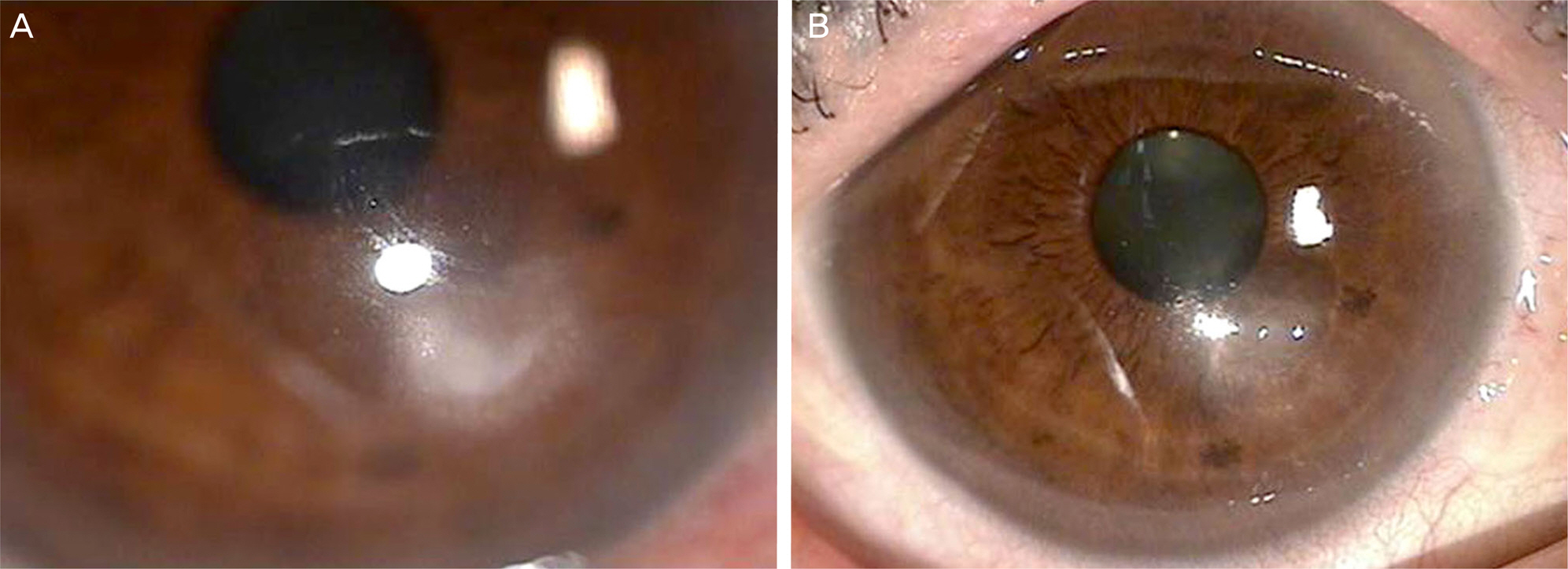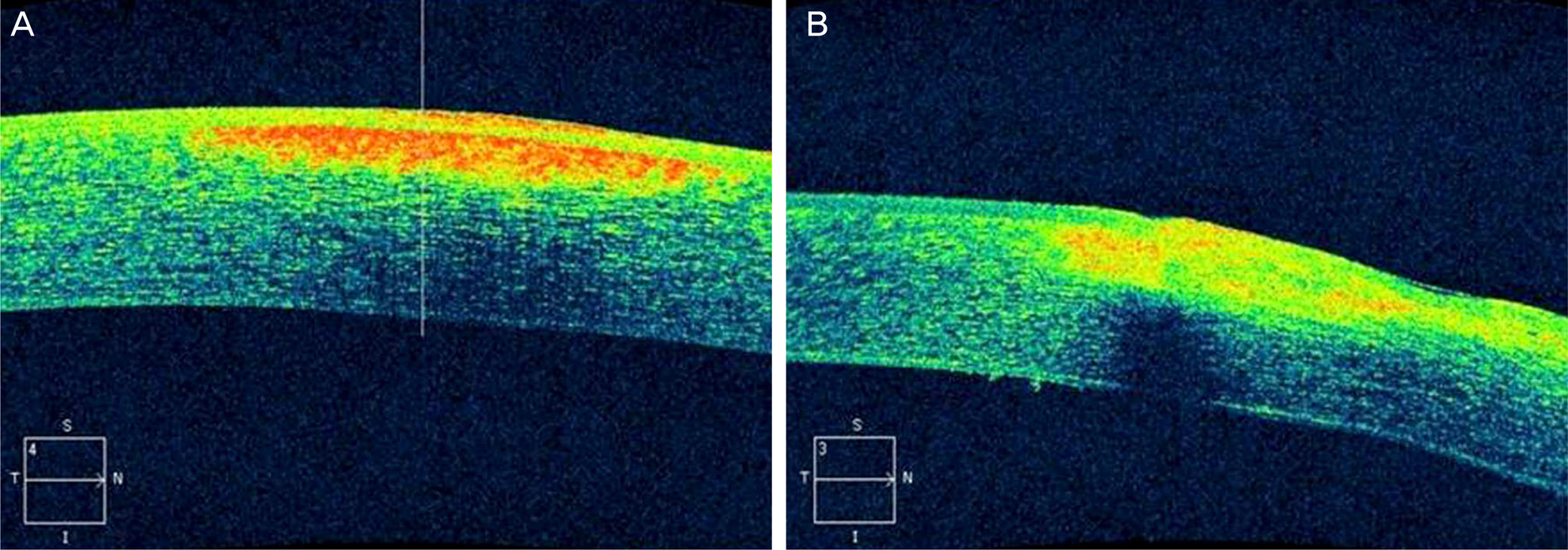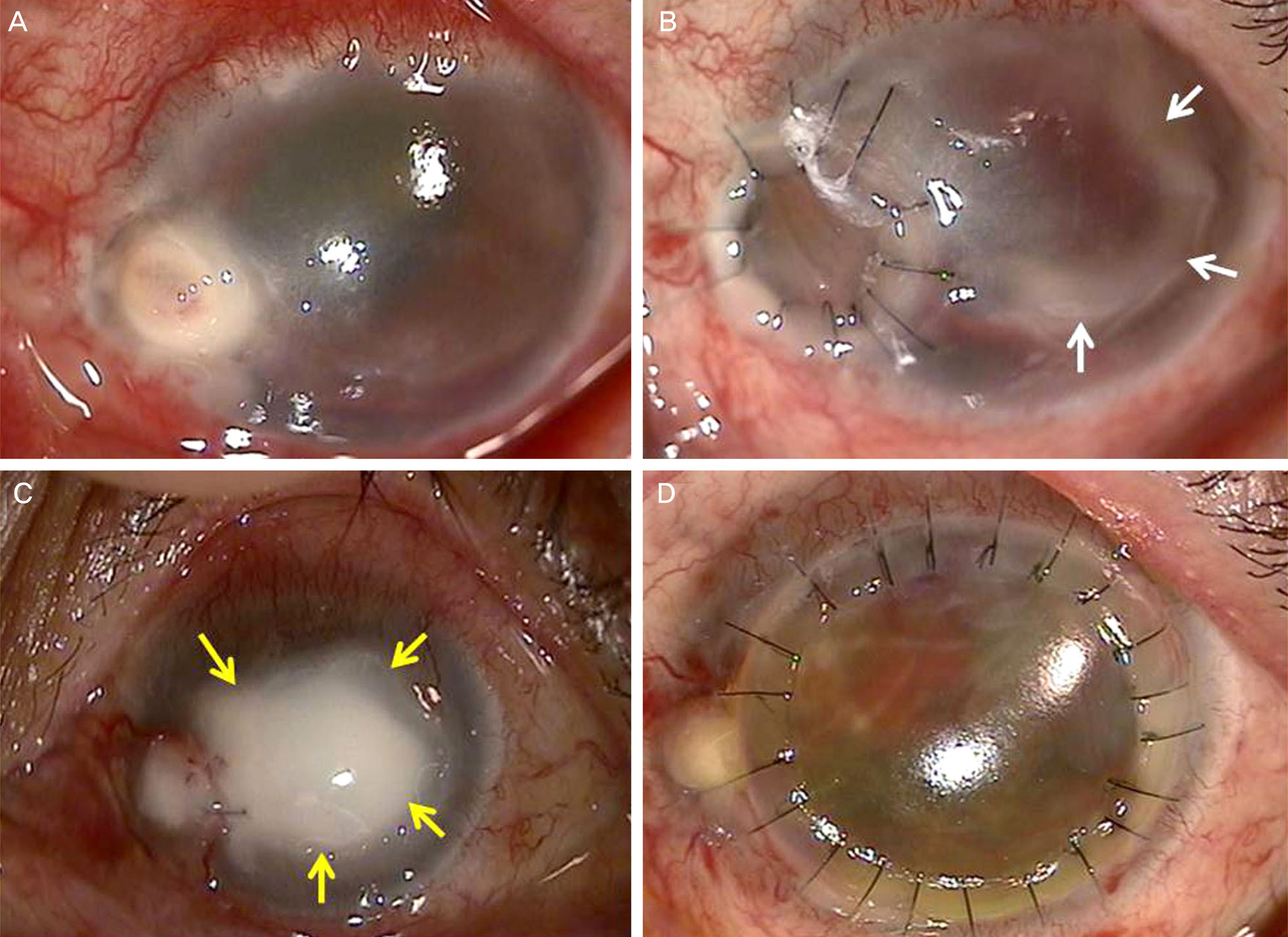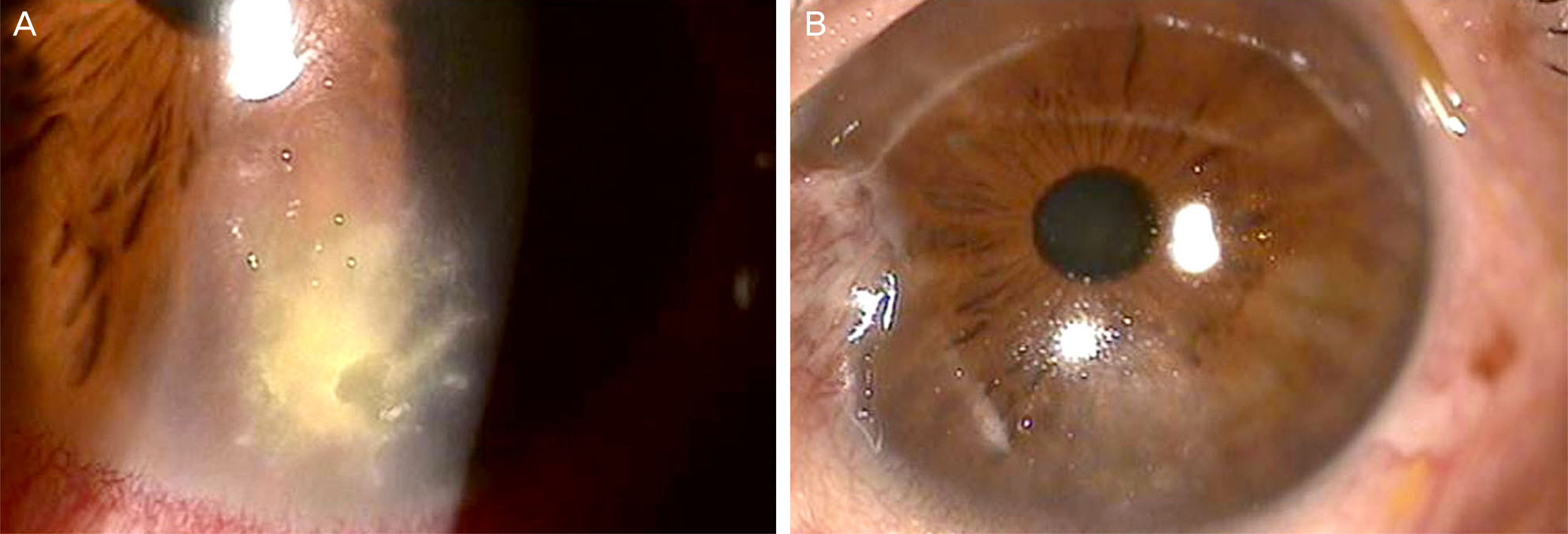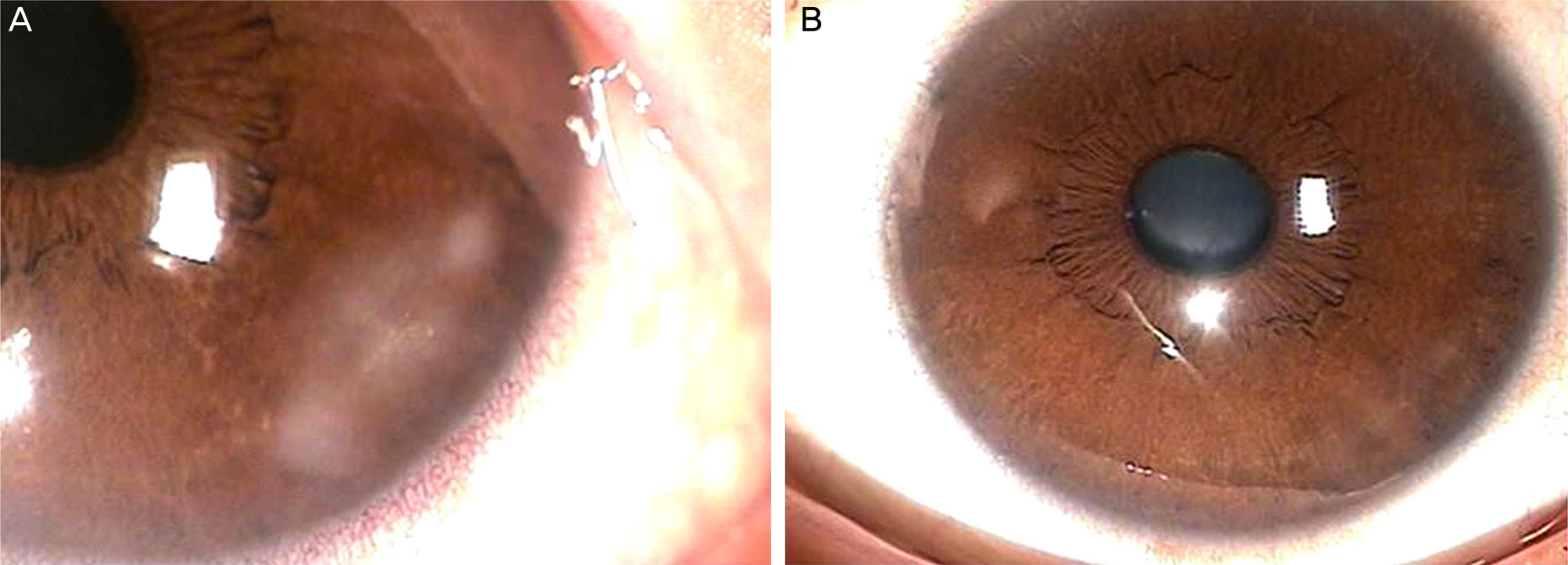J Korean Ophthalmol Soc.
2015 Apr;56(4):607-613. 10.3341/jkos.2015.56.4.607.
Clinical Features of Acinetobacter Baumannii Keratitis
- Affiliations
-
- 1Department of Ophthalmology, Dankook University Hospital, Dankook University College of Medicine, Cheonan, Korea. perfectcure@daum.net
- KMID: 2215714
- DOI: http://doi.org/10.3341/jkos.2015.56.4.607
Abstract
- PURPOSE
Acinetobacter species are common aerobic gram-negative bacterium that contain polymorphisms. Acinetobacter baumannii keratitis has recently received attention, and has various clinical features. Therefore, it is crucial to determine the appropriate medical treatment for Acinetobacter baumannii keratitis.
CASE SUMMARY
There were two infectious crystalline keratitis patients, two other patients that were co-infected with fungus, and the last patient who had the peripheral corneal ulcer type of keratitis.
CONCLUSIONS
Acinetobacter baumannii keratitis demonstrates multiple clinical features. It forms a biofilm that can bring possible resistance to therapy, and it can also co-infect with fungus. In contrast to general bacterial keratitis which occurs in the form of a central corneal ulcer, we found Acinetobacter baumannii to take on the form of a peripheral corneal ulcer in our experiments on the five keratitis patients. Although Acinetobacter species were originally found to be multidrug-resistant, such resistance was not found in our experiments. However, due to the various problems associated with Acinetobacter baumannii, it is always critical for medical staff to take infection of Acinetobacter baumannii into consideration in keratitis patients.
Keyword
MeSH Terms
Figure
Cited by 1 articles
-
Polymicrobial Keratitis of Pseudomonas aeruginosa, Acinetobacter baumannii, and Ochrobactrum anthropi
Jung Youb Kang, Ju Hwan Song, Ki Yup Nam, Seung Uk Lee, Sang Joon Lee
J Korean Ophthalmol Soc. 2019;60(5):474-479. doi: 10.3341/jkos.2019.60.5.474.
Reference
-
References
1. Eveillard M, Kempf M, Belmonte O, et al. Reservoirs of Acinetobacter baumannii outside the hospital and potential involvement in emerging human community-acquired infections. Int J Infect Dis. 2013; 17:e802–5.
Article2. Marcovich A, Levartovsky S. Acinetobacter exposure keratitis. Br J Ophthalmol. 1994; 78:489–90.
Article3. Zabel RW, Winegarden T, Holland EJ, Doughman DJ. Acinetobacter corneal ulcer after penetrating keratoplasty. Am J Ophthalmol. 1989; 107:677–8.
Article4. Crawford PM Jr, Conway MD, Peyman GA. Trauma-induced Acinetobacter lwoffi endophthalmitis with multi-organism recurrence: strategies with intravitreal treatment. Eye (Lond). 1997; 11(Pt 6):863–4.
Article5. Melki TS, Sramek SJ. Trauma-induced Acinetobacter lwoffi endophthalmitis. Am J Ophthalmol. 1992; 113:598–9.6. Gopal L, Ramaswamy AA, Madhavan HN, et al. Postoperative endophthalmitis caused by sequestered Acinetobacter calcoaceticus. Am J Ophthalmol. 2000; 129:388–90.
Article7. Prashanth K, Ranga MP, Rao VA, Kanungo R. Corneal perforation due to Acinetobacter junii: a case report. Diagn Microbiol Infect Dis. 2000; 37:215–7.
Article8. Khater TT, Jones DB, Wilhelmus KR. Infectious crystalline keratopathy caused by gram-negative bacteria. Am J Ophthalmol. 1997; 124:19–23.
Article9. Corrigan KM, Harmis NY, Willcox MD. Association of acinetobacter species with contact lens-induced adverse responses. Cornea. 2001; 20:463–6.
Article10. Kim ST, Lee YC, Heo J, Koh JW. A case of acinetobacter baumannii keratitis after contact lens wearing. J Korean Ophthalmol Soc. 2008; 49:1696–700.
Article11. Choi JK, Kim IH, Seo JW. A case of keratitis caused by combined infection of multidrug-resistant acinetobacter baumannii and candida parapsilosis. J Korean Ophthalmol Soc. 2012; 53:1167–71.12. Ruiz J, Núñez ML, Pérez J, et al. Evolution of resistance among clinical isolates of Acinetobacter over a 6-year period. Eur J Clin Microbiol Infect Dis. 1999; 18:292–5.13. Peleg AY, Seifert H, Paterson DL. Acinetobacter baumannii: emergence of a successful pathogen. Clin Microbiol Rev. 2008; 21:538–82.14. Zarrilli R, Giannouli M, Tomasone F, et al. Carbapenem resistance in Acinetobacter baumannii: the molecular epidemic features of an emerging problem in health care facilities. J Infect Dev Ctries. 2009; 3:335–41.
Article15. Gorovoy MS, Stern GA, Hood CI, Allen C. Intrastromal non-inflammatory bacterial colonization of a corneal graft. Arch Ophthalmol. 1983; 101:1749–52.
Article16. Meisler DM, Langston RH, Naab TJ, et al. Infectious crystalline keratopathy. Am J Ophthalmol. 1984; 97:337–43.
Article17. Zabel RW, Mintsioulis G, MacDonald I, Tuft S. Infectious crystalline keratopathy. Can J Ophthalmol. 1988; 23:311–4.18. Kintner JC, Grossniklaus HE, Lass JH, Jacobs G. Infectious crystalline keratopathy associated with topical anesthetic abuse. Cornea. 1990; 9:77–80.
Article19. Matsumoto A, Sano Y, Nishida K, et al. A case of infectious crystalline keratopathy occurring long after penetrating keratoplasty. Cornea. 1998; 17:119–22.
Article20. Ormerod LD, Ruoff KL, Meisler DM, et al. Infectious crystalline keratopathy. Role of nutritionally variant streptococci and other bacterial factors. Ophthalmology. 1991; 98:159–69.21. Elder MJ, Stapleton F, Evans E, Dart JK. Biofilm-related infections in ophthalmology. Eye (Lond). 1995; 9(Pt 1):102–9.
Article22. Hunts JH, Matoba AY, Osato MS, Font RL. Infectious crystalline keratopathy. The role of bacterial exopolysaccharide. Arch Ophthalmol. 1993; 111:528–30.23. Costerton JW, Cheng KJ, Geesey GG, et al. Bacterial biofilms in nature and disease. Annu Rev Microbiol. 1987; 41:435–64.
Article24. Gordon NC, Wareham DW. Multidrug-resistant Acinetobacter baumannii: mechanisms of virulence and resistance. Int J Antimicrob Agents. 2010; 35:219–26.
Article25. Lee HW, Koh YM, Kim J, et al. Capacity of multidrug-resistant clinical isolates of Acinetobacter baumannii to form biofilm and adhere to epithelial cell surfaces. Clin Microbiol Infect. 2008; 14:49–54.
Article26. Cevahir N, Demir M, Kaleli I, et al. Evaluation of biofilm pro-duction, gelatinase activity, and mannose-resistant hemagglutination in Acinetobacter baumannii strains. J Microbiol Immunol Infect. 2008; 41:513–8.27. Vidal R, Dominguez M, Urrutia H, et al. Biofilm formation by Acinetobacter baumannii. Microbios. 1996; 86:49–58.28. Sridhar MS, Sharma S, Garg P, Rao GN. Epithelial infectious crystalline keratopathy. Am J Ophthalmol. 2001; 131:255–7.
Article29. Sánchez Ferreiro AV, López Criado A, Muñoz Bellido L. [Crystalline keratopathy in pterigium treatment: case report]. Arch Soc Esp Oftalmol. 2012; 87:179–81.
Article
- Full Text Links
- Actions
-
Cited
- CITED
-
- Close
- Share
- Similar articles
-
- A Case of Acinetobacter Baumannii Keratitis After Contact Lens Wearing
- Successful Treatment of Acinetobacter Baumannii Meningitis with Colistin
- A Case of Keratitis Caused by Combined Infection of Multidrug-Resistant Acinetobacter Baumannii and Candida Parapsilosis
- Carbapenem-Resistant Acinetobacter baumannii
- Septic Shock Caused by Acinetobacter Baumannii in Postoperative Patient


